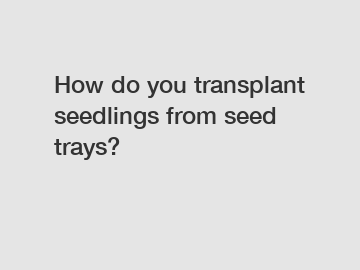How do you transplant seedlings from seed trays?
How do you transplant seedlings from seed trays?
When it comes to gardening, the process of transplanting is a crucial step in the growth of seedlings. Transferring seedlings from their seed trays to bigger pots or directly into the ground allows them to continue flourishing into strong and healthy plants. However, this process requires careful attention and proper technique to ensure the successful establishment of the seedlings in their new environment. In this article, we will walk you through the steps involved in transplanting seedlings, offering valuable insights to help you achieve the best results.
1. Timing is Key:

Transplant seedlings when they have developed their first true leaves, as this indicates they are robust enough to handle the transfer. Waiting too long can lead to root congestion and stunted growth. Similarly, transplanting them too early may result in weak and vulnerable plants. Be patient and observe your seedlings closely to find the ideal time to transplant.
2. Prepare the New Environment:
Before transplanting your seedlings, it is essential to ensure the new environment is ready to receive them. Whether you plan to move them into larger pots or directly into your garden, make sure the soil or potting mix is well prepared. Remove any weeds, loosen the soil, and incorporate organic matter if needed. This preparation allows for better root development and nutrient uptake once the seedlings are transferred.
3. Handle with Care:
When removing the seedlings from their trays, it is crucial to handle them with care to avoid damaging the delicate stems and roots. To ease their extraction, gently tap on the bottom of the tray or press on the soil around the individual seedlings. Hold the seedlings by their leaves instead of pulling them by their stems, as the stems are more susceptible to injury. By being gentle, you will minimize the shock experienced by the seedlings during the transplant process.
4. Transplanting Technique:
Dig a small hole in the prepared soil or potting mix using a dibber or your fingers. The hole should be deep enough to accommodate the seedling without bending or crowding its roots. Remove the seedling from the tray, ensuring you have a good grasp of the root ball. Place the seedling into the hole and gently fill the soil or potting mix around it, making sure the roots are covered but not overly compacted. Lightly press the soil or mix around the base of the seedling to provide stability.
5. Adequate Watering:
Proper watering is crucial after transplanting seedlings to help them establish themselves in their new environment. Water the seedlings immediately after transplanting, ensuring the soil is moist but not soaked. Maintain regular watering sessions to keep the soil consistently moist, but avoid overwatering, as it can lead to root rot. As the seedlings settle in and grow, adjust the frequency and amount of watering accordingly.
6. Gradual Acclimatization:
If you plan to transplant your seedlings directly into your garden, it is important to gradually acclimate them to the outdoor conditions. This process, known as hardening off, involves exposing the seedlings to outdoor conditions for short periods over a few days. Begin by placing them in a sheltered spot for a couple of hours and gradually increase their exposure to sunlight and wind. This gradual transition will help the seedlings adapt to the new environment and prevent transplant shock.
In conclusion, transplanting seedlings from seed trays is a critical step in their growth journey. By following the steps outlined above, you can ensure a successful transition for your seedlings, promoting their health and vigor. Remember to time your transplant carefully, prepare the new environment adequately, handle the seedlings with care, employ proper transplanting techniques, provide adequate water, and gradually acclimate them to their new surroundings. By applying these practices, you can boost the chances of your seedlings thriving and enjoy a bountiful garden or pot of healthy plants. Happy gardening!
If you are looking for more details, kindly visit 128 Cell Plastic Plug Trays, 98 cell sprouting trays, 32 cell seed tray.

Comments
0